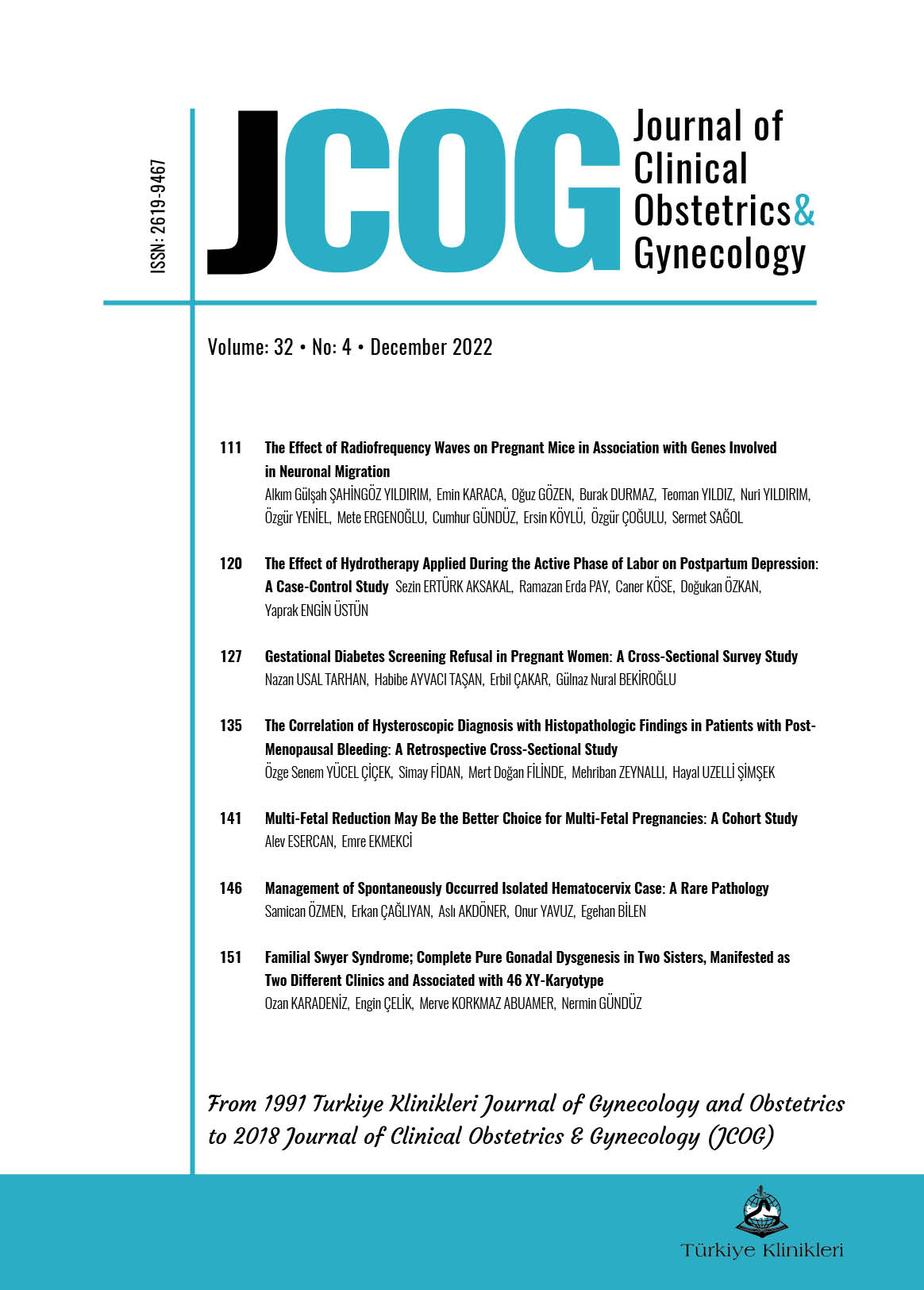Open Access
Peer Reviewed
ORIGINAL RESEARCH
1813 Viewed1329 Downloaded
Multi-Fetal Reduction May Be the Better Choice for Multi-Fetal Pregnancies: A Cohort Study
Received: 09 May 2022 | Accepted: 28 Sep 2022 | Available online: 13 Oct 2022
JCOG. 2022;32(4):141-5
DOI: 10.5336/jcog.2022-91239
Article Language: EN
Article Language: EN
Copyright Ⓒ 2025 by Türkiye Klinikleri. This is an open access article under the CC BY-NC-ND license (http://creativecommons.org/licenses/by-nc-nd/4.0/)
ABSTRACT
Objective: The rate of multiple pregnancies increases the number of pregnancies conceived using assisted reproductive techniques. Although the studies indicate a positive effect of multi-fetal pregnancy reduction on pregnancy outcomes, procedure-associated miscarriages should be considered. Therefore, our study aimed to evaluate the outcomes of pregnancies that have undergone multi-fetal reduction and compare the pregnancies' outcomes without any intervention. Material and Methods: Patients from the Perinatology Clinic of Şanlıurfa Training and Research Hospital were selected between July 2017 and May 2021. The patients in the study group were divided into two groups: those with or without multi-fetal reduction. Obstetric outcomes of pregnancies were compared between the groups. Results: During this period, 95 gestations with three or more fetuses were applied to our clinic. Eighteen multi-fetal reduction procedures were performed because of multiple pregnancies. Reductions were performed from five to twins in one case, triplets to twins in ten, and quadruplets to twins in seven cases. Patients preferred to continue pregnancies without intervention in 6 quadruplets, one sextile, and 66 triplet pregnancies. Mean gestational age at birth in the intervention group was 34.43±0.40 (32-38) weeks, while in the non-intervened group, that was 30.46±0.48 (24-37) gestational weeks. Gestational age at birth was significantly lower in the non-intervention group. (p: 0.000029). Conclusion: Multi-fetal reduction is beneficial in preventing preterm delivery.
Objective: The rate of multiple pregnancies increases the number of pregnancies conceived using assisted reproductive techniques. Although the studies indicate a positive effect of multi-fetal pregnancy reduction on pregnancy outcomes, procedure-associated miscarriages should be considered. Therefore, our study aimed to evaluate the outcomes of pregnancies that have undergone multi-fetal reduction and compare the pregnancies' outcomes without any intervention. Material and Methods: Patients from the Perinatology Clinic of Şanlıurfa Training and Research Hospital were selected between July 2017 and May 2021. The patients in the study group were divided into two groups: those with or without multi-fetal reduction. Obstetric outcomes of pregnancies were compared between the groups. Results: During this period, 95 gestations with three or more fetuses were applied to our clinic. Eighteen multi-fetal reduction procedures were performed because of multiple pregnancies. Reductions were performed from five to twins in one case, triplets to twins in ten, and quadruplets to twins in seven cases. Patients preferred to continue pregnancies without intervention in 6 quadruplets, one sextile, and 66 triplet pregnancies. Mean gestational age at birth in the intervention group was 34.43±0.40 (32-38) weeks, while in the non-intervened group, that was 30.46±0.48 (24-37) gestational weeks. Gestational age at birth was significantly lower in the non-intervention group. (p: 0.000029). Conclusion: Multi-fetal reduction is beneficial in preventing preterm delivery.
REFERENCES:
- Dickens BM, Cook RJ. Multiple pregnancy: legal and ethical issues. Int J Gynaecol Obstet. 2008;103(3):270-4. [Crossref] [PubMed]
- Kisa Karakaya B, Celik H, Esercan A, Aktulay A, Ustun Y, Yapar Eyi EG, et al. Our results of spontaneously conceived triplet pregnancies. Medicine Science. 2018;7(2):312-4. [Link]
- Evans MI, Britt DW. Fetal reduction. Semin Perinatol. 2005;29(5):321-9. [Crossref] [PubMed]
- Zipori Y, Haas J, Berger H, Barzilay E. Multifetal pregnancy reduction of triplets to twins compared with non-reduced triplets: a meta-analysis. Reprod Biomed Online. 2017;35(3):296-304. [Crossref] [PubMed]
- Hasson J, Shapira A, Many A, Jaffa A, Har-Toov J. Reduction of twin pregnancy to singleton: does it improve pregnancy outcome? J Matern Fetal Neonatal Med. 2011;24(11):1362-6. [Crossref] [PubMed]
- Bardin R, Gupta M, Greenberg G, Nandrajog A, Tenenbaum-Gavish K, Gupta N, et al. Fetal reduction from twin to singleton gestation: a meta-analysis. Int J Gynaecol Obstet. 2022;158(2):260-9. [Crossref] [PubMed]
- Papageorghiou AT, Avgidou K, Bakoulas V, Sebire NJ, Nicolaides KH. Risks of miscarriage and early preterm birth in trichorionic triplet pregnancies with embryo reduction versus expectant management: new data and systematic review. Hum Reprod. 2006;21(7):1912-7. [Crossref] [PubMed]
- Herlihy N, Naqvi M, Romero J, Gupta S, Monteagudo A, Rebarber A, et al. Multifetal pregnancy reduction of trichorionic triplet gestations: what is the benefit? Am J Perinatol. 2017;34(14):1417-23. [Crossref] [PubMed]
- Hessami K, Evans MI, Nassr AA, Espinoza J, Donepudi RV, Cortes MS, et al. Fetal reduction of triplet pregnancies to twins vs singletons: a meta-analysis of survival and pregnancy outcome. Am J Obstet Gynecol. 2022;227(3):430-9.e5. [Crossref] [PubMed]
- Drugan A, Weissman A. Multi-fetal pregnancy reduction (MFPR) to twins or singleton-medical justification and ethical slippery slope. J Perinat Med. 2017;45(2):181-4. [Crossref] [PubMed]
MENU
POPULAR ARTICLES
MOST DOWNLOADED ARTICLES





This journal is licensed under a Creative Commons Attribution-NonCommercial-NoDerivatives 4.0 International License.










